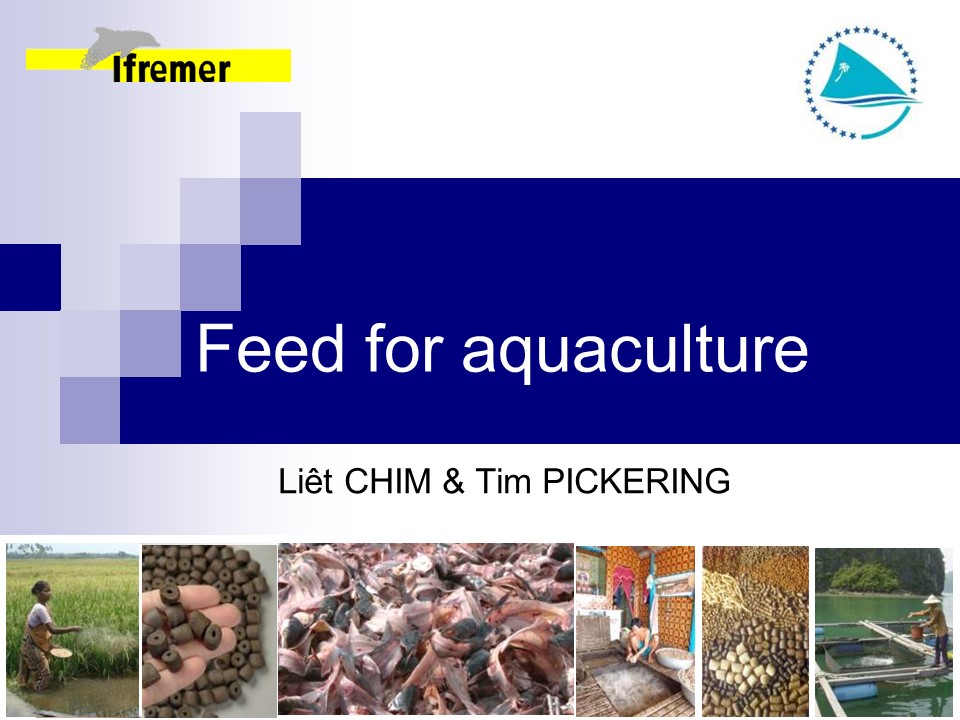Feed for aquaculture - PowerPoint PPT Presentation
1 / 15
Title:
Feed for aquaculture
Description:
Rabbit fish (Siganus lineatus) culture project. Estimated waste fish FIFO ratio = 0.6. ... Diapositive 1 Last modified by: franckm Company: IFREMER ... – PowerPoint PPT presentation
Number of Views:279
Avg rating:3.0/5.0
Title: Feed for aquaculture
1
Feed for aquaculture
- Liêt CHIM Tim PICKERING
2
Feeding fish to fish shellfish
- Three main ways of fish using in aquafeeds
- As fresh fish usually in the form of trash
fish, either used directly or mixed as a slurry
or mash. Frozen whole pelagic fish are also used
for fattening tuna and other large fish in cages. - As fishmeal and fish oil mainly derived from
the reduction of whole small pelagic fish to a
concentrated high protein form/oil that is used
in formulating compounded feeds. - As processing or other waste fishmeal can be
produced from fish processing waste (trimmings,
offcuts and offal).
3
Feeding fresh/frozen fish
Tuna and Yellowtail culture
In Asia, marine and finfish aquaculture still
depends upon either trash fish. This represents a
simple, cheap and readily available source of
protein, although conversion ratios and
environmental performance are poor.
4
Feeding fresh/frozen waste fish in Fiji
10
30
10
30
60 (Wet weight)
(Dry weight)
Using tuna waste in Fidji for Tilapia farming
5
Feeding processed fish meal, oil, hydrolysat
Three main ways of fish using in aquafeeds As
fresh fish usually in the form of trash fish,
either used directly or mixed as a slurry or
mash. Frozen whole pelagic fish are also used for
fattening tuna and other large fish in cages.
As fishmeal and fish oil mainly derived from
the reduction of whole small pelagic fish to a
concentrated high protein form/oil that is used
in formulating compounded feeds. As processing
or other waste fishmeal can be produced from
fish processing waste (trimmings, offcuts and
offal).
6
Fishmeal and fish oil world production
- Raw materials
- Whole wild fish 17-18 million tons
- By products 5 - 6 million tons
- Total 22-23 million tons
- Production of
- Fishmeal 5- 6 million tons
- Fish oil 1 million tons
7
Use of wild fish for animal husbandry
5600000 mT meal 1170000 mT oil
23366000 mT wild fish ?
8
Fish meal and oil for aquafeed
- 81 Fish Oil
- 63 Fish meal
9
Around 25 of Fish Meal derived from by-products
(Chamberlain A., 2011. Fishmeal and Fish Oil
The facts, figures, trends and IFFOs responsible
supply standard)
10
Fish-In Fish-Out (FIFO)
- Quantity of whole wild fish needed for
feeds/Quantity of farmed fish produced
Marine shrimp FIFO ratio (25 2/ 23 5) x 2.5
2.4
() Jackson, 2009. Fish In Fish Out (FIFO)
Ratios explained International Fishmeal and
Fish Oil Organisation
11
(After Jackson, A. 2011 IFFO publication)
1 kg of reared fish and shellfish
0,66 kg of fish
12
Case study 1 in New Caledonia
Shrimp culture Annual production (mT)
1500 Average FCR 2.5 FIFO ratio
2.4
Quantity of equivalent whole fish imported
annualy 2.4 x 1500 3600 tons
Quantity of Fish waste available locally 1000
tons
Potential saving on imported fish to feed shrimp
28
(Photo H. Lemonnier)
13
Case study 2 in New Caledonia
Rabbit fish (Siganus lineatus) culture
project Estimated waste fish FIFO ratio 0.6
1000 mT fish waste could produce 1600 mT of whole
rabbit fish for human consumption
14
Case study in Fidji
- The actual production
- 100 mT of Tilapia
- 25 mT of Macrobrachium
- Tilapia FIFO ratios
- Whole fish 0.3
- Waste fish 0.7
- Fresh water shrimp FIFO ratios
- Whole fish 0.5
- Waste fish 1
Whole fish required 0.3 x 100 0.5 x 25
42.5 tons Waste fish required 0.7 x 100 1
x 25 95.0 tons
15
Conclusions
- Fish is an important ingredient to feed fish and
shellfish aquaculture - The fish waste products locally available
represent an important protein source for the
development of aquaculture in South Pacific
countries. - To feed the aquaculture farms with the fish
processing wastes allows to make savings on
expensive imported fish meal.































